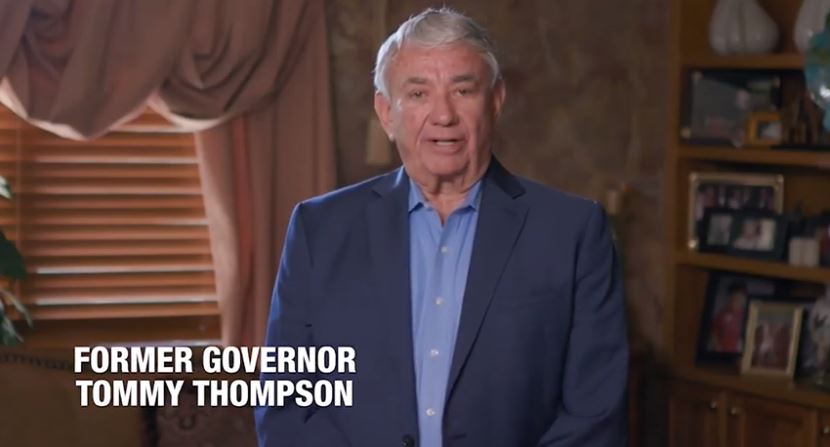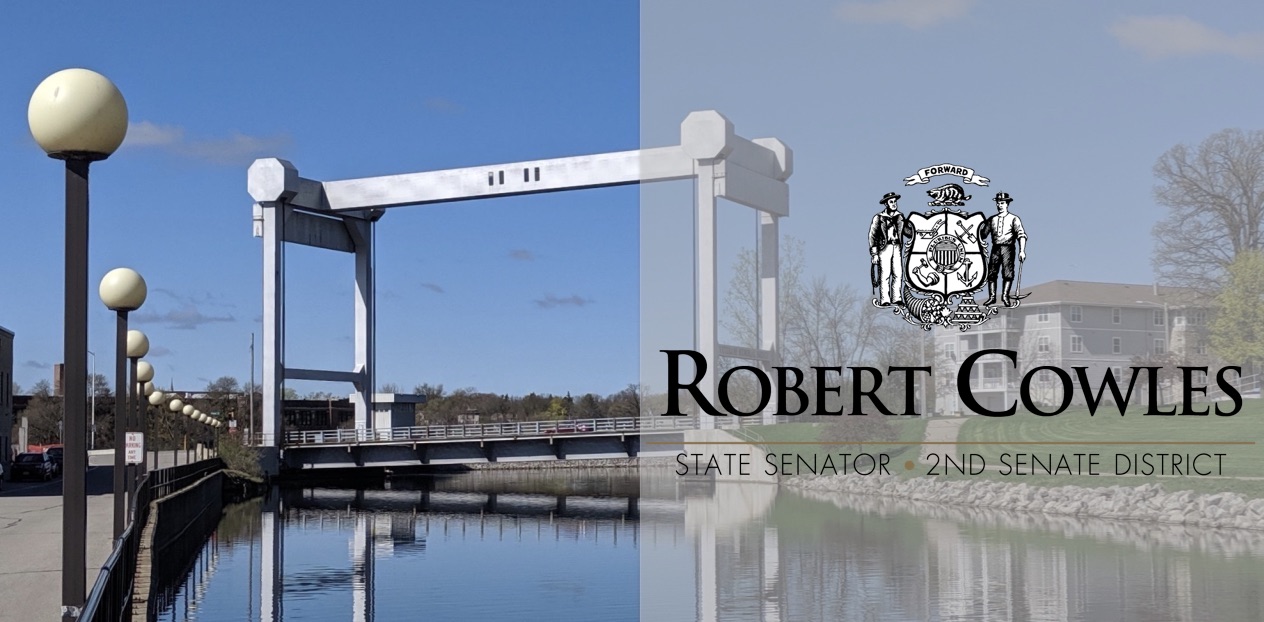|
Dear Friends and Neighbors,
As we enter the summer season with warmer temperatures
and sunny days, we’re hopefully getting the COVID-19
outbreaks under control. While Wisconsin continues to
see hundreds of new cases on a daily basis, increased
testing efforts have meant that we’re consistently
seeing below or around 5% of daily tests come back
positive. This 5% threshold has been an important
barrier noted by state and federal health officials, as
it shows that the number of individuals that have
COVID-19 as a share of those tested is remaining low.
However, that doesn’t mean the Coronavirus is over, and
as Wisconsin recovers from the outbreak and economic
slowdown, I have some new information I wanted to share
with residents of Northeast Wisconsin which I’ve
included below.
Coronavirus Relief Fund Spending Plan Unveiled
The Coronavirus Relief Fund, part of the federal
Coronavirus Aid, Relief, and Economic Security (CARES)
Act, provided direct payments to state governments and
local governments with a population in excess of 500,000
to help respond to the COVID-19 outbreak and the
surrounding economic conditions. In the May 11th Updates
from the State Senate e-newsletter, I discussed some of
the other pots of federal funding our state would
receive and how it will be allocated, but at the time,
we didn’t have any details on how this approximately $2
billion would be spent.
Over the past couple of weeks, seven different
announcements by the Governor, who has control over the
Coronavirus Relief Fund, have given us a better picture
on how he intends on spending these funds under the
federal guidelines, which includes that funding must be
spent by the end of the year, among other restrictions.
Below, I’ll provide a brief overview of all seven
announcements and point out how you may be impacted by
this funding.
Small Business Grant Program
$75 million was allocated to the ‘We’re All In’ Small
Business Grant Program to provide grants of $2,500 each
to 30,000 businesses. While the application period
doesn’t open until June 15th, you can learn more about
eligibility, what information you’ll need to be able to
apply, and other frequently asked questions on the
Wisconsin Economic Development Corporation’s website.
The application period will only be open for one week
with applications due by June 21st. If you are planning
on applying for this funding, I encourage you to be
ready with your application materials since one-week is
not a long time-frame to submit information.
Relief for Farmers
$50 million was allocated in financial relief for
farmers through direct payments to aid with their losses
due to low market prices from the Coronavirus. We are
awaiting more details on eligibility, application
processes, when payments will be distributed, and more,
and I’ll be sure to distribute that information on
social media as soon as it’s available.
Assistance for Renters
$25 million was allocated to assist renters who’ve
experienced a loss of an income due to the Coronavirus.
Individuals can apply through a local Community Action
Program (CAP) Association member to receive up to $3,000
for owed rent or security deposits, paid directly to the
landlord on behalf of the tenant, if the renter
otherwise meets the eligibility criteria. You can learn
more about eligibility and find the CAP that serves your
area on the
Department of Administration’s (DOA) website.
Combatting Hunger
$15 million was allocated to help combat hunger as the
demand for food assistance has risen in the past few
months. One portion of the program will help food banks,
pantries, and other related nonprofits with their extra
expenses during the COVID-19 outbreak, and a second
portion will fund applicants that bolster the food
supply chain to strengthen connections with local
farmers. No further details on which agency will run the
program or how the funding will be distributed is
available at this time.
Aid for Local Governments
$200 million was allocated to assist every local and
tribal government in the state with their extra expenses
due to Coronavirus. $10 million was set aside for tribal
nations, and $190 million was allocated for local
governments, with the four counties and sixty town,
village or city governments at least partly in the 2nd
Senate District having just over $14.6 million
allocated. See the amounts for each community on
DOA’s website. Starting July 1st and bimonthly
through November 1st, local governments can submit their
expenses and receive reimbursements from their
predetermined allotment.
Over the past few weeks, I’ve been trying to work with
the Governor to get funding from the Coronavirus Relief
Fund allocated to Brown County given their extraordinary
expenses due to a sizable COVID-19 outbreak. Under the
‘Routes to Recovery’ aid in this program, Brown County
may receive up to about $4.3 million. While this
certainly is a start, I do not believe it is enough due
to the area being second only to the City of Milwaukee
in number of positive cases.
Out of the $190 million, the Governor provided an
additional $33.6 million to three local governments,
Dane and Milwaukee Counties and the City of Milwaukee,
even after those three already received over $250
million directly in Coronavirus Relief Funding. This
meant that, when the funding was announced, Dane County
received about $159,600 per case of COVID-19 or $206 per
resident, while Brown County received $1,800 per case
and $31 per resident.
In short, Dane and Milwaukee received plenty of aid to
begin with, and the extra $33.6 million was unnecessary
and could have been used better. Learn more and read
comments from County Executive Troy Streckenbach and I
in this
Green Bay Press Gazette article.
Grants for Healthcare Providers
$100 million was allocated to assist emergency medical
services, home and community-based health services, and
long-term care providers, such as nursing homes, with
their costs incurred to help fight the spread of
COVID-19. There will be a first wave of funding made
available soon to support more immediate needs, with a
second wave coming later to target more individualized
needs. The Department of Health Services will award the
release of this funding.
Statewide Effort for Testing and Healthcare
Preparedness
$1,170 million was allocated for a series of healthcare
priorities, including:
-
$260 million for testing, some of which will be made
available to local governments
-
$75 million for contact tracing, $50 million of
which will be made available to local governments
-
$150 million for acquisition of personal protective
equipment for healthcare facilities, first
responders and local governments
-
$40 million for the procurement of ventilators
-
$445 million to prepare hospitals and communities
for a potential second surge of COVID-19 cases
-
$200 million for expenses incurred in the State
Emergency Operations Center, a joint effort lead by
the Department of Military Affairs but involving
many different state agencies
What’s Next?
Of the $1,997.6 million that was awarded to Wisconsin
from the Coronavirus Relief Fund, the amounts allocated
above should leave about $360 million in available
funding. While we await further announcements on how
this funding may be utilized to offset COVID-19
expenses, I’m hoping to see additional consideration
given to the impacts to local businesses from the ‘Safer
at Home’ order.
In a UW-Oshkosh study released on April 22nd, weeks
before the ‘Safer at Home’ order was lifted, the
statewide economic impact was projected to be
substantial. With $79 million in income lost, $29
million in inventory lost, and $119 million in other
financial losses from the 1,126 respondents, the
economic impact certainly extends beyond the $75 million
allocated by the Governor in the Small Business Grant
Program.
In the NEW North region, which includes all four
counties in the 2nd Senate District, of the 411
respondents, about 23% of businesses said they had less
than three months under the conditions of the ‘Safer at
Home’ order where they could remain viable, and 22.7%
that applied for federal assistance programs didn’t
receive any aid. See the full study results on
UW-Oshkosh’s website.
With this in mind, more aid for businesses impacted by
COVID-19 seems prudent, but it’s not the only expense
that I hope is kept in mind. While renters may be
assisted, those with mortgages may have suffered the
same loss of an income but cannot receive assistance.
While local governments received aid, it was calculated
based on population and didn’t account for the
extraordinary expenses of local governments with sizable
outbreaks, such as Brown County. And while healthcare
facilities, including long-term care facilities,
received some aid, it falls well short of the true
impact those facilities felt from COVID-19.
With $360 million in remaining funding and a myriad of
priorities with the Coronavirus Relief Fund allocations,
I would like to see the Governor use more of this
funding to help areas directly impacted with outbreaks,
provide additional support to the business community and
infuse more funding to long-term care facilities to more
fully offset the impact that COVID-19 has had on our
economy. We need to work to get the remainder of this $2
billion back to the people impacted most so we can get
our economic engines started again and provide help to
restore our communities back to normal.
Focus Forward Provides Tips for Business Leaders
The Wisconsin Economic Development Corporation (WEDC)
understands that these have been unprecedented times,
and wants to help get our economy back on track. With
their new Focus Forward website, they’ve provided a
series of resources for businesses, communities, and
consumers that can make us better prepared for an
economic recovery and to reinstate the prosperity with
which we entered the new year. Along with other
information, on this page you can find a few videos,
aired originally as livestreams over the past few weeks,
covering a number of topics that provide useful tips for
Wisconsin’s business leaders. Learn more about Focus
Forward and find the videos on
WEDC’s website.
New Marketplace Helps to Promote Main Street
From Shawano to Clintonville to Kaukauna and elsewhere
throughout the 2nd Senate District, Main Street
businesses are a large part of the foundation of
communities of all sizes throughout our state, and now
more than ever, they need our patronage. The Wisconsin
Economic Development Corporation (WEDC) has created Main
Street Marketplace, an online directory that is making
it a little easier to find some of these unique
community staples. Learn more about the new Marketplace
in a
Spectrum News 1 story, or search the Marketplace on
WEDC’s website.
Thanks to Local Banks for Playing Your Part
Some area businesses have needed a lifeline during the
COVID-19 shutdowns. Thanks to the work of a number of
great community banks and credit unions, many businesses
did receive the helping hand they needed to stay afloat
until they were able to reopen.
While some local lending intuitions created their own
loan or even grant programs, and many others found
innovative ways to help, I want to take a moment to
thank the banks and credit unions with locations in the
2nd Senate District that participated in the Paycheck
Protection Program, a federal forgivable loan program
discussed in several previous e-newsletters, including:
-
AbbyBank
-
Associated Bank
-
Bank First
-
Bay Bank
-
Community First Credit Union
-
Denmark State Bank
-
East Wisconsin Savings Bank
-
First National Bank
-
First State Bank
-
Fox Cities Credit Union
-
GreenStone Farm Credit Services
-
Nicolet National Bank
-
North Shore Bank
-
Premier Community Bank
-
U.S. Bank
-
Wells Fargo Bank
-
Wolf River Community Bank
Thank you to these banks and credit unions for your part
in helping our communities make it through the hardest
part of COVID-19! Your role often plays out in the
background, but you deserve recognition for your
commitment and assistance.
Veterans Benefit Resource Center Ready to Help
Wisconsin veterans with questions during these uncertain
times about the benefits they’ve earned are encouraged
to reach out to the Wisconsin Department of Veterans
Affairs’ (DVA) Veterans Benefits Resource Center. Staff
are available for questions Monday to Friday from 7:45am
to 4:15pm by phone at 1-800-947-8387, by email at
WisVets@dva.wisconsin.gov, or by live chat on
DVA’s
website. A listing of many local, state, and federal
benefits available to veterans can also be found on
DVA’s website. You can find that listing
here.
Hospitals and Clinics Are Safe to Seek Care
There can be serious short and long-term consequences to
your health and wellbeing if you put off routine or
emergency medical care. Recently, the Wisconsin Hospital
Association partnered with former Governor and U.S.
Health and Human Services Secretary Tommy Thompson to
create a commercial and radio ad to remind everyone that
hospitals and clinics are clean and safe, and that
they’re taking the necessary precautions to continue
providing outstanding care even with COVID-19 still
being a concern. Watch the ad by clicking on the image
below.

Economic Impact Payment Information
The federal Economic Impact Payments, commonly referred
to as stimulus checks, have already been delivered to
most Americans, but some are still waiting for the
$1,200 or other amount from the federal CARES Act. If
you still haven’t received your Economic Impact Payment,
the Internal Revenue Service has created a hotline,
1-800-919-9835, where you can speak with someone to get
answers about the status of your payment. Alternatively,
you can still visit their website to see frequently
asked questions and check the status of your payment
online.
Until Next Time
My staff and I continue to remain available to assist
with questions you may have involving state government.
While we may not always have the answer right away,
we’ll do our best to assist with your questions and
concerns involving COVID-19 or other issues related to
state government.
To find the most up-to-date information on the
Governor’s actions, including the ‘Safer at Home’ order,
along with each state agency’s role in this outbreak,
I’d encourage you to visit
this
website. To find the most up-to-date numbers on
confirmed cases of COVID-19 in Wisconsin, visit the
Department of Health Services’ website. You can also
find the information I’ve shared in my last eleven
e-newsletters on COVID-19 by visiting
my website.
And as always, please feel free to
contact my office with any questions or concerns you
may have, and be sure to connect with me on
Facebook,
Twitter, and
Instagram for regular updates on Coronavirus and
more from around the 2nd Senate District and in the
State Capitol.
Thanks for reading!

Senator Robert Cowles
Proudly Serving Wisconsin's 2nd Senate District
|

